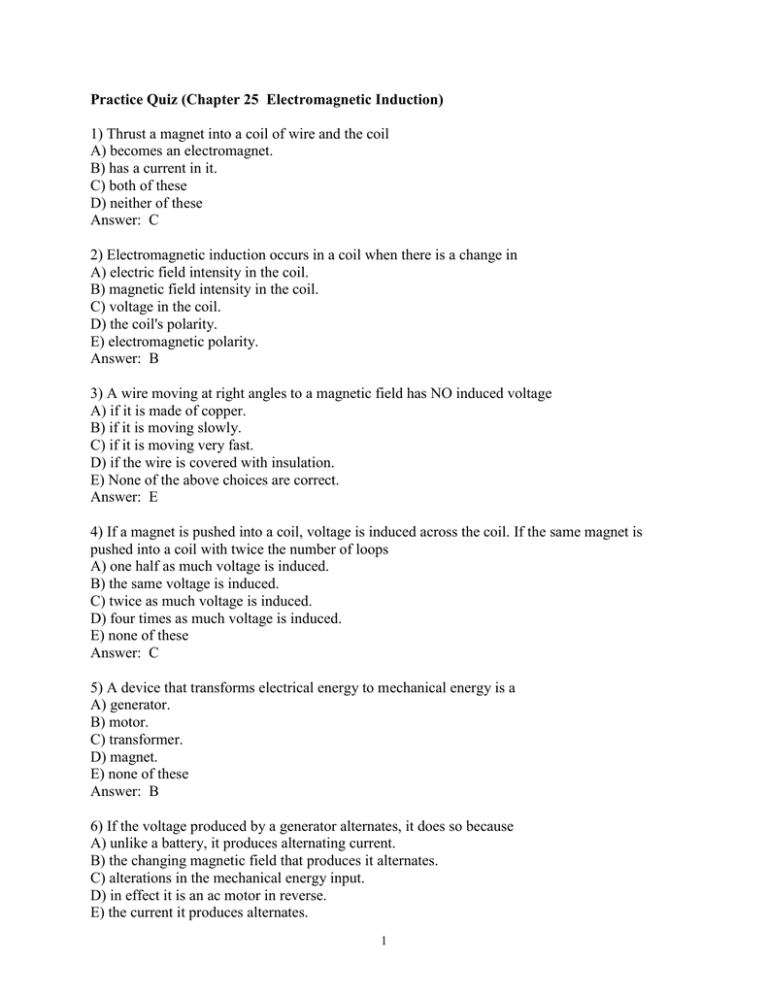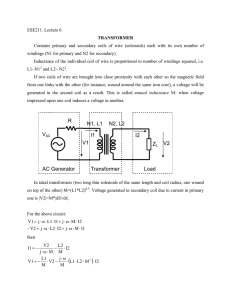Practice Quiz (Chapter 25 Electromagnetic Induction) 1) Thrust a
advertisement

Practice Quiz (Chapter 25 Electromagnetic Induction) 1) Thrust a magnet into a coil of wire and the coil A) becomes an electromagnet. B) has a current in it. C) both of these D) neither of these Answer: C 2) Electromagnetic induction occurs in a coil when there is a change in A) electric field intensity in the coil. B) magnetic field intensity in the coil. C) voltage in the coil. D) the coil's polarity. E) electromagnetic polarity. Answer: B 3) A wire moving at right angles to a magnetic field has NO induced voltage A) if it is made of copper. B) if it is moving slowly. C) if it is moving very fast. D) if the wire is covered with insulation. E) None of the above choices are correct. Answer: E 4) If a magnet is pushed into a coil, voltage is induced across the coil. If the same magnet is pushed into a coil with twice the number of loops A) one half as much voltage is induced. B) the same voltage is induced. C) twice as much voltage is induced. D) four times as much voltage is induced. E) none of these Answer: C 5) A device that transforms electrical energy to mechanical energy is a A) generator. B) motor. C) transformer. D) magnet. E) none of these Answer: B 6) If the voltage produced by a generator alternates, it does so because A) unlike a battery, it produces alternating current. B) the changing magnetic field that produces it alternates. C) alterations in the mechanical energy input. D) in effect it is an ac motor in reverse. E) the current it produces alternates. 1 Answer: B 7) A transformer actually transforms A) voltage. B) magnetic field lines. C) generators into motors. D) non-safe forms of energy to safe forms of energy. E) All of the above choices are correct. Answer: A 8) Transformers use ac so there will be the required A) transfer of energy from coil to coil. B) voltage for transformation. C) change in magnetic field for operation. D) change in input current. E) magnetic field intensities. Answer: C 8) The output power of an ideal transformer is A) greater than the input power. B) equal to the input power. C) smaller than the input power. D) may be any of these Answer: B 10) Power is transmitted at high voltages because the corresponding current in the wires is A) also high to deliver appreciable power to distant places. B) low so that overheating of the wires is minimized. C) Choices A and B are both true. D) Choices A and B are both false. Answer: B 11) The metal detectors that people walk through at airports operate via A) Ohm's law. B) Faraday's law. C) Coulomb's law. D) Newton's laws. E) civil laws. Answer: B 12) A step-up transformer has a ratio of one to ten. Neglecting slight losses, if 100 W of power go into the primary coil, the power coming from the secondary coil is A) 1 W. B) 10 W. C) 100 W. D) 1000 W. E) none of these Answer: C 2 13) Metal detectors, like the ones used at airports, are activated by A) electric fields. B) magnetic fields. C) electromagnetic induction. D) alternating current. Answer: C 14) The major advantage of MHD generators over conventional generators is that MHD generators A) do not use electromagnetic induction. B) do not require magnets. C) require no power input. D) all of these E) none of these Answer: E 15) The voltage across the input terminals of a transformer is 110 V. The primary has 50 loops and the secondary has 25 loops. The voltage the transformer puts out is A) 25 V. B) 55 V. C) 110 V. D) 220 V. E) none of these Answer: B 16) Disregarding the effects of friction, a cyclist will coast farther when a lamp powered by a wheel generator is A) of low wattage. B) of high wattage. C) burned out. D) none of these Answer: C 3




